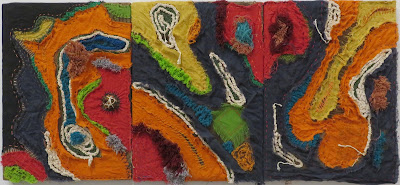A major part of the Venice Biennale is the curated exhibition, whose theme often inspires many of the national pavilions and the collateral and other additional exhibitions that accompany the Biennale, spreading across Venice in museums and a panoply of other spaces. This year’s curator was Adriano Pedrosa, who adopted the title “Foreigners Everywhere,” “Stranieri Ovunque,” from an installation initiated by a Paris-born, Palermo-based collective Claire Fontaine in 2004. This series of neon sculptures, each of which shows the expression in a different language was installed in my favorite part of the Arsenale, the large arcaded internal dock .
 |
| Claire Fontaine, Foreigners Everywhere, suspended neons, framework, transformers, cables and fittings. |
 |
| Wall of portraits with tiny Kahlo and its security guard |
I was pleased to recognize an image by Twins Seven Seven,
 |
| Twins Seven Seven, The Architect, 1989 Ink on plywood, glued and carved |
a Nigerian artist I had recently discovered, who was included in the famous 1989 exhibition at the Centre Pompidou, “Magicians of the Earth.” And among the abstractions was a characteristic painting by Esther Mahlangu,
a South African artist known for painting her abstract designs on buildings. She also was included in “Magicians of the Earth,” and was also commissioned by BMW to decorate a car.
 |
| Esther Mahlangu, Untitled, 1990 Acrylic on canvas. Work on top |
The Italians Everywhere section in the Arsenale was a different viewing experience. The section included artists who were born in Italy but emigrated elsewhere. Each work is hung on a single glass panel with the label on the back. The installation is the one Lina Bo Bardi (1914-1992) used for the audacious building of the Sao Paolo Museum of Art (curator Pedrosa’s home institution), which she designed and which opened in 1968. Bo Bardi won the Golden Lion for Architecture posthumously in 2021. She herself was an Italian - born in Rome – who moved to Brazil in 1946. I remembered this celebrated installation design from when I was in Sao Paolo in 1981. There, as in Venice, it was unusual and also problematic. If you wanted to look at the painting and glance at the label, you couldn’t; if you wanted to compare two works, or look at a group together, it was very difficult. All the works of art face the same direction, so you cannot turn around and see a group in a room. Looking is harder work, unless you only want to see one thing at a time and don’t need label information. It never surprised me that the system was not adopted elsewhere, but it was still fun to see it again in Venice.
 |
| Bo Bardi installation objects from the front |
 |
| Bo Bardi installation, objects from the back |
.
Here's also a Joseph Stella from that section.  |
| Joseph Stella, Fountain, 1929, oil on canvas |
 |
| Santiago Yahuarcani, Peru, b. 1960, Aqui esta caliente, 2024 Natural pigments and acrylic on llanchama Bordadores de Isla Negra, Chile, two details from Untitled, 1972 Embroidered canvas |
Coincidentally, a surprising number of the works were fiber: woven, collaged, or painted with narratives or abstractions. Some of these, like the two above, were also by outsider artists. I photographed at least 15. While there has been an increase in the presentation of fiber works in art exhibitions, artists such as Faith Ringgold, Olga de Amaral and Magdalena Abakanowicz, and while Yinka Shonibare incorporates African textiles in his works, it is still perceived more as a craft then a contemporary art medium, much like clay and glass. Several of the abstract fiber works were monumental and stunningly lovely. Here are just four:
 |
| Nour Jaouda, If the Olive Trees Knew, 2023 Libyan, born in Cairo, lives in Cairo and London Hand-dyed textile, steel |
 |
| Dana Awartani, Palestinian, born in Jeddah, Saudi Arabia, Lives in Jeddah and New York Come, Let Me Heal Your Wounds, Let Me Heal Your Broken Bones 2024, darning on medicinally dyed silk |
 |
| Antonia Jose Guzman and Iva Jankovic Panama and Serbia, live in Amsterdam Orbital Mechanics, 2024 Installation with Ayrakh hand block printed indigo dyed fabrics |
 |
Sàngódáre Ġbádégẹsin Àjàlá, Nigeria, Unknown title, batik |
Another focus of the exhibition is Queer art, seen throughout the show and in two designated sections in each of the two main buildings, one devoted to Queer abstraction. In the Short Guide he identifies himself as “the first openly Queer curator in the history of the Biennale Arte.”















.jpg)




.JPG)

.JPG)
.JPG)
.JPG)



.JPG)
.JPG)

.JPG)
.JPG)
.JPG)
.JPG)
.JPG)
.JPG)

.JPG)
.JPG)
.JPG)